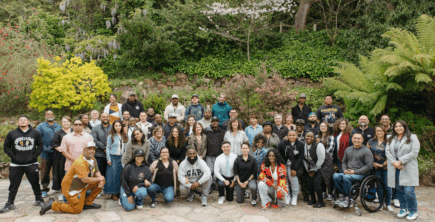
LGBT

2019 has been a year of challenge and opportunity for the nonprofit sector, from responding to urgent issues worldwide to navigating a changed US tax code that impacts giving. Fundraising is a dynamic, ever-shifting practice for nonprofits, and strategies that worked in the past often need to evolve to stay impactful. To this end, Tides is launching Finishing Off Strong: Empowering Nonprofits to Inspire Year-End Giving, a series of best practices and case studies designed to empower our partners and fellow nonprofits to finish 2019 with successful fundraising.
In the coming weeks leading up to Giving Tuesday (December 3rd) and year-end fundraising efforts, Tides will publish a series of content that highlights successful strategies and approaches that deliver positive giving results across the social impact ecosystem. Among other topics, we’ll discuss navigating the new tax code, showcase success stories from fellow nonprofits, discuss how to make the ask, and include best practices on how to continually evolve your donor cultivation strategies to stay competitive. Stay tuned for biweekly posts in Tides Perspectives on our website this fall, with our next post coming up the week of October 14th.
Read on for our first post, which focuses on how the 2018 Tax Cuts and Jobs Act (TCJA) is impacting individual and family giving and what strategies nonprofits can leverage to cultivate year-end giving and to thrive within this new financial landscape.
Together, we can energize donors, inspire giving, and finish off 2019 strong.
Since its launch in 2018, the Tax Cuts and Jobs Act (TCJA) has impacted the way individuals and families donate. As donors reevaluate giving practices in light of the new tax code, it’s essential for the nonprofit sector to shift strategies in order to thrive within this new landscape. Although the new system presents fundraising challenges for nonprofits, understanding the barriers to giving and identifying non-financial giving motivations can set nonprofits up for successful fundraising for year-end and beyond.
2018 was the first year that the new tax code came into effect, and the nonprofit sector is feeling the consequences. From 2014 to 2017, year-over-year giving continued to rise, with average annual growth hovering around 2.8% when adjusted for inflation1. Once the TCJA came into effect, giving declined 1.7% from 2017 to 2018, with the largest decrease in giving (3.4%) by individuals (Giving USA). The most recent data from the Fundraising Effectiveness Project suggests a similar trend for the first half of this year, with a year-to-decline of 5.8% in the number of donors, and a 7.3% percent decline in dollars raised.
According to the Tax Policy Center, this decrease is a consequence of a greater number of individuals and families utilizing the larger standardized deduction under the TCJA, which does not allow for tax savings from charitable contributions for many households that do not have itemized deductions above the new threshold, $12,000 for individuals and $24,000 for families. As a result, some donors have less incentive to give.
As the tax benefits of giving decrease, successful nonprofits are shining a spotlight on what motivates donors beyond tax benefits. End-of-year is a critical time for engaging donors, and participation in Giving Tuesday is a key tactic that inspires giving, even without clear tax benefits.
Despite the challenges presented by the new tax code, individual and family donors sprang into action during Giving Tuesday last year, and nonprofits saw 2018 Giving Tuesday results increase by 27% from 2017 to 2018, with $380 million raised in the US. Key tactics and trends that contributed to the success include:
But year-end planning goes beyond Giving Tuesday. Although some nonprofits wait until the very end of the year to assess performance, proactively assessing fundraising goals throughout the year provides a macro view of the fundraising landscape and how that affects your success with donors. As a nonprofit leader, here are some questions you can ask yourself now to gauge performance:
Many Tides partners have felt the impact of the changing tax code and have identified strategies that help foster deeper year-round connections with donors and encourage giving, including:
Build your relationship with consistent communication: Let donors and supporters know how their support directly impacts your nonprofit’s success, and share a special sneak peek about what’s coming next for your organization. Monthly (or frequent) donor-focused newsletters are a great way to keep funders engaged, while regular impact reports allow donors to see exactly how their dollars make a difference.
Don’t be afraid to make the ask: Ask supporters to become donors, and donors to become recurring donors. As Classy highlights in an analysis on givings trends, only 14% of organizations prompt one-time donors to upgrade to recurring gifts.
Develop strategies to encourage monthly gifts: Recurring donors who give on a monthly basis donate 440% more to a nonprofit than one-time donors. Be creative with your deep engagement strategies—here are a few great examples:
Use metrics to gauge the effectiveness of different campaigns or fundraising asks: As you develop and share new outreach campaigns with your donors and community, it’s important to also track performance to gauge which messages resonate the most with your community. DonorSearch has a great list of 16 fundraising success metrics to track, and below are a few of our top choices to consider.
Nonprofit need donors to fund their transformative work more than ever. Individual donors often provide critical general operating support, and nonprofits benefit from having a wider and more diverse group of supporters to create stability within this altered fundraising landscape. With individual giving on the decline, donors can have an especially significant impact through their gifts.
The TCJA tax code has altered the giving landscape, especially with individual giving, but Tides is dedicated to empowering our partners with tools and resources to continue successful fundraising within this new framework. Our Tides team looks forward to providing fundraising support to social change and nonprofit leaders to help navigate this changing environment. More to come!
We’d like to hear your feedback about the usefulness of this post and other topics that you would be interested in learning about in Finishing Off Strong: Empowering Nonprofits to Inspire Year-End Giving. Please take our three-minute survey to help shape the remaining content in our series!
Photo by Jean Lakosnyk on Unsplash

LGBT

Corporate Partners

Philanthropy

Read the stories and hear the voices of social change leaders fighting for justice.